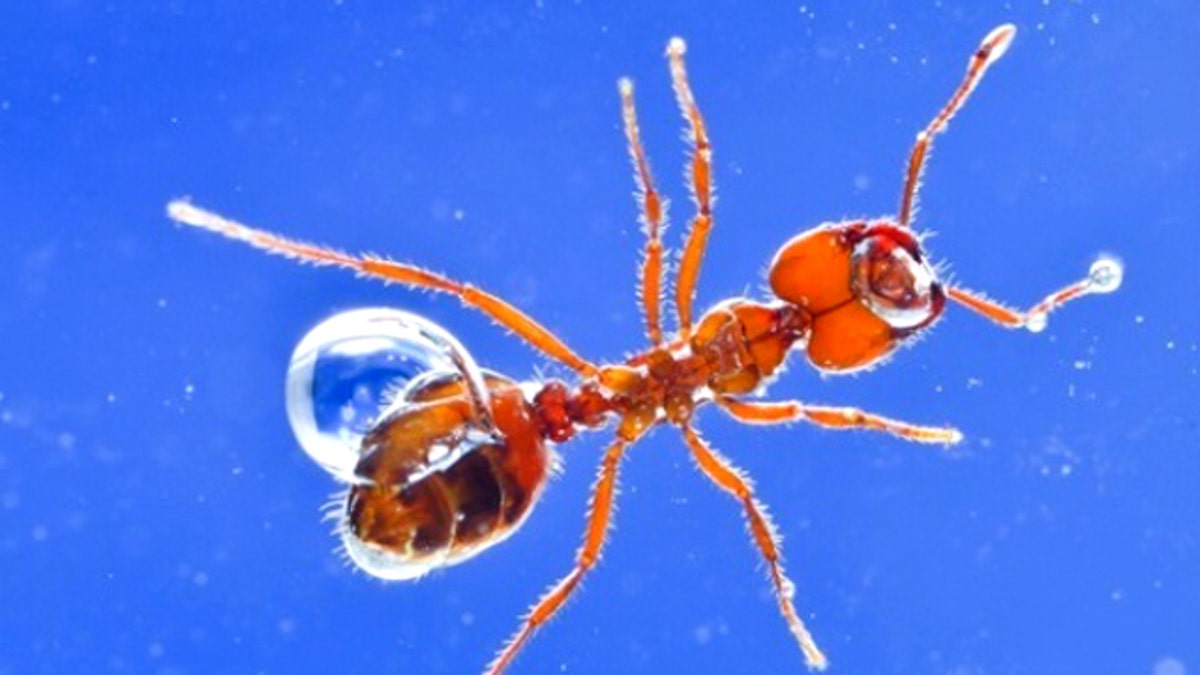
Ants float because of the buoyancy of the air bubbles trapped next to their bodies. A thin layer of air can be seen around its antennae and body as well. (Ant Laboratory, Georgia Institute of Technology)
The ants may go marching one by one, but they end up forming a superstructure of thousands -- and together they can form a raft that stretches the boundaries of the laws of physics, according to new research released today.
Ants have exoskeletons that are naturally hydrophobic, or water repellant. A single ant can walk on water because of the buoyancy of the air bubbles trapped next to its body, and the water's own surface tension. However, when thousands of ants stand on top of each other, their multiplied weight should cause them to sink. But for years, biologists have observed fire ant colonies floating down flood plains and rivers in their native South America.
For the first time, a group of engineers has attacked the question of ant flotation from a physics perspective. Ants float as a group because they can harness the power of nearby air bubbles. Grasping each other's mandibles or front legs with a force 400 times their body weight, the ants are able to trap small pockets of air between them -- like a group floatation device.
"The ants are so tightly knit together, that air pockets form between the water and the ants, and water cannot penetrate through any part," said Nathan Mlot, a graduate student at the Georgia Institute of Technology in Atlanta and one of the study's authors.
The bottom layer of ants rests on top of the water's surface, and others pile on above them. Even when they do get submerged, the pockets of air bring them back to the surface quickly -- and allow them to breathe. When they get submerged, the ants flex their muscles in unison to form a tighter weave.
To understand exactly how the structure worked, the researchers took a raft of several thousand ants and dropped it in liquid nitrogen, immediately freezing it. Then they were able to look at the structure on an ant-by-ant level under an electron-scanning microscope. "We were surprised at just how waterproof raft was -- its ability to repel water and keep afloat," said Mlot.
What if you want to drown the ants? Just add soap to the water, which greatly reduces its surface tension of water and sinks the raft, said Mlot. "With soap, the ants will drown within a matter of seconds, whereas they can survive for days or even weeks on the raft otherwise."
To test some of the behavioral dynamics inside the pancake-shaped raft, the researchers painstakingly picked ants one by one from the top of the structure. Soon, a new one would climb from the bottom to keep the raft the same thickness.
"We know that self-assembly and self-healing are attributes of living organisms, and we have seen that ant rafts develop these on a macro scale," said Mlot. The study was published today in the journal Proceedings of the National Academy of Sciences.
"Each ant does one tiny job, but they can build these incredible structures," said Kenneth Ross, an entomologist with the University of Georgia who was not involved in the work. Ross says that the rafts include not only worker ants, but also the queen and her brood -- the reproductive cells of the giant superorganism. From what he has seen in his research, the queen usually stays in the center of the raft, with an even tighter ball of ants around her.
This level of social organization isn't common, said Joshua King, an insect ecologist at the Central Connecticut State University, in New Britain. "This study reinforces how unique the collective behaviors of social insects are when compared to other animals."
This type of research could eventually help in many fields, from making a better rain jacket to building robots that can think. When the ants link up their mandibles and legs, they form a highly waterproof weave, which could be the basis for next-generation materials for lifejackets or boats. In addition, social insects like ants have long been the inspiration for autonomous robotics that could link up to build a larger structure.
"Ants are like little computers, acting on a few simple rules of engagement," said Mlot.
